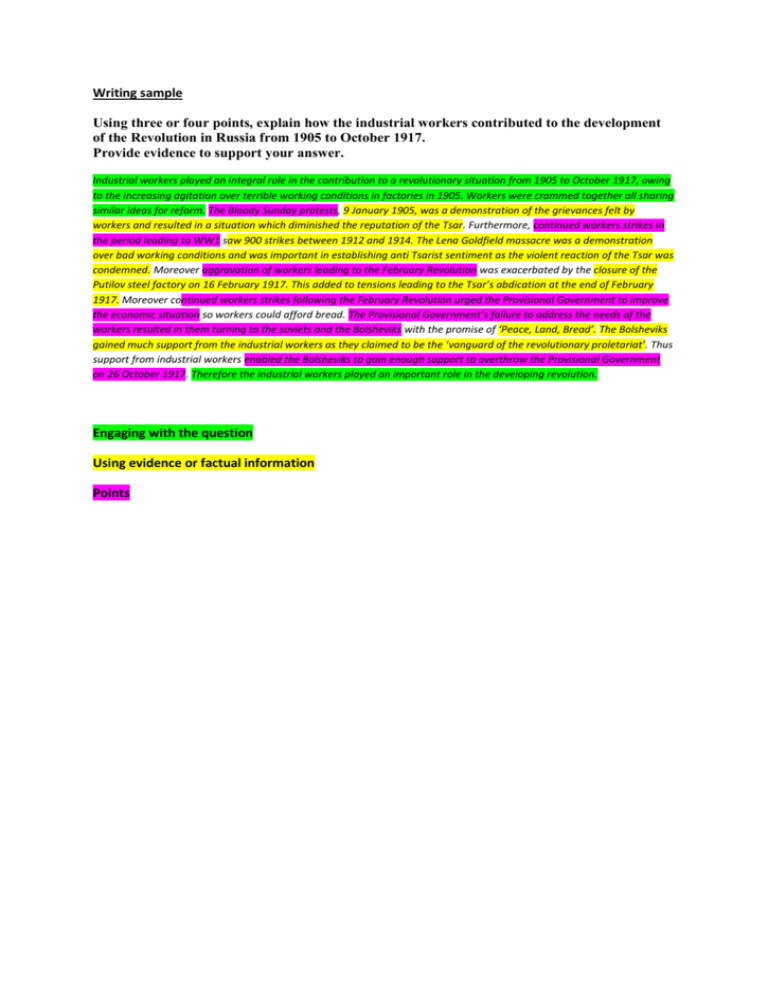File
advertisement

Writing sample Using three or four points, explain how the industrial workers contributed to the development of the Revolution in Russia from 1905 to October 1917. Provide evidence to support your answer. Industrial workers played an integral role in the contribution to a revolutionary situation from 1905 to October 1917, owing to the increasing agitation over terrible working conditions in factories in 1905. Workers were crammed together all sharing similar ideas for reform. The Bloody Sunday protests, 9 January 1905, was a demonstration of the grievances felt by workers and resulted in a situation which diminished the reputation of the Tsar. Furthermore, continued workers strikes in the period leading to WW1 saw 900 strikes between 1912 and 1914. The Lena Goldfield massacre was a demonstration over bad working conditions and was important in establishing anti Tsarist sentiment as the violent reaction of the Tsar was condemned. Moreover aggravation of workers leading to the February Revolution was exacerbated by the closure of the Putilov steel factory on 16 February 1917. This added to tensions leading to the Tsar’s abdication at the end of February 1917. Moreover continued workers strikes following the February Revolution urged the Provisional Government to improve the economic situation so workers could afford bread. The Provisional Government’s failure to address the needs of the workers resulted in them turning to the soviets and the Bolsheviks with the promise of ‘Peace, Land, Bread’. The Bolsheviks gained much support from the industrial workers as they claimed to be the ‘vanguard of the revolutionary proletariat’. Thus support from industrial workers enabled the Bolsheviks to gain enough support to overthrow the Provisional Government on 26 October 1917. Therefore the industrial workers played an important role in the developing revolution. Engaging with the question Using evidence or factual information Points Scaffold How to answer the question: -Directly ‘jump into’ answering the question on a broad level -First point + evidence + explanation -Second point + evidence + explanation -Third point + evidence + explanation -Fourth point + evidence + explanation -Final link back to the question The problems facing pre-revolutionary Russia from the late 1800s to the early 1900s involved _____________________________________________________ . First, ______________________________________________________, leading to____________________________________________. Subsequently, ____________________________________________________occurred, resulting in __________________________________________which __________________________________________________________________. Third, __________________________________________________________________________________ ___________________________________________________________________, which____________________________________________________________________________. Finally, this generated __________________________________________________________________________________ __________________________, which ___________________________________________, thus providing the context for a revolutionary situation in the early twentieth century. Remember: -To write down accurate dates -To refer to specific policies, slogans, names, places, events -Use evidence where you can (statistics, quotes from primary sources, detailed descriptions of events) –DO NOT rely on historians’ opinions -To use linking words and transitional phrases (eg: first, second, third + subsequently, led to, furthermore, consequently, resulted in, generated, created, etc) -To consistently link back to the question and answer all parts -Stay within the date range!











